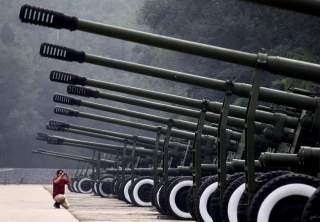China Wants to Build a Massive Underwater Tunnel to Taiwan. What Could Go Wrong?
Well, a lot--for Taiwan.
Beijing’s building spree over the past decade has seen the inauguration of a raft of mega-projects throughout China. State media are currently ballyhooing the completion of the Hong Kong-Zhuhai-Macau Bridge, as the 55-kilometer tunnel-bridge structure that snakes through the Pearl River Estuary. The man-made marvel in the sea, as it’s being hailed, is slated to open to traffic in the second half of the year.
More ambitious bridges and tunnels have been laid out on Beijing’s drawing board of future projects. They include rail and expressway links spanning the Bohai Sea as well as the Qiongzhou Strait that separates Guangdong from the southern resort island of Hainan.
But to Beijing, no project matters as much as a tunnel that would run beneath the Taiwan Strait to span the chasm – of transportation as well as politics – between the two sides of that shallow stretch of water.
Nonetheless, reports exploring the giant tunnel’s feasibility so far only appear in Chinese news media, the most recent one being a feature on the Chinese news portal Sohu this year. Meanwhile politicians in Taiwan still label the idea “nonsensical” and shun any discussion related to it.
Recommended: We Went Aboard the Most Powerful Aircraft Carrier Ever Built.
Recommended: This Is How China Would Invade Taiwan (And How to Stop It).
Recommended: The Story of the F-52 Fighter.
That said, the tunnel was gazetted in 2016, under the name of the “Beijing-Taipei expressway and rail link,” in China’s 13th Five-Year Plan (2016-2020), albeit with an indefinite timetable for implementation.
Beijing’s unilateral move caused a commotion in Taipei, so much so that the island’s legislature convened an urgent session during which then-premier Simon Chang gave a vehement disavowal, slamming the way Beijing had broached the project as well as the “tunnel vision” of its dealings with the self-ruling island.
But Beijing cadres including Wang Mengshu, China’s top railway engineer and one of the most ardent advocates of the tunnel, soon hit back. He said the two sides had been discussing the plan for a decade and that the Taiwanese president at the time, Ma Ying-jeou, was aware of, and possibly facilitated, the proposal.
Before long Taiwanese papers revealed that one of Ma’s confidants was the “point person” in a number of covert liaisons with Wang’s team.
Wang and China Railway Corp have proposed three routes across the strait, with the most feasible one linking Fuzhou, capital of Fujian province, with western Taiwan’s Hsinchu county.
At 122 kilometers, the tunnel would be more than twice as long as the Channel Tunnel between France and the United Kingdom.
Many in Taiwan fear the tunnel might give the Chinese military a shortcut to the island to marshal soldiers if they could control the Hsinchu exit for just a couple of hours. Taipei is only about 80km north of the beachhead.
But Wang has retorted that the People’s Liberation Army was capable of mounting an amphibious invasion in the event of a war and waiting to use a future tunnel as a shortcut made no sense. He added that by the time the tunnel was up and running, the two governments might have long ago achieved reconciliation as well as a deal not only to delineate the use of the tunnel but the future of cross-strait relations as a whole.
Taiwan’s current pro-independence President Tsai Ing-wen has fallen foul of Beijing with her defiant rebuff of the one-China policy, and now that the rapport with the mainland enjoyed by her predecessor is long gone, such a cross-strait tunnel can only remain on paper for the foreseeable future.
But Wang said in a recent interview that there was no reason to call it quits and scrap the plan in toto, stressing top-level endorsement as well as the fact that preliminary studies and feasibility assessments for a project of this magnitude would take decades to complete.

